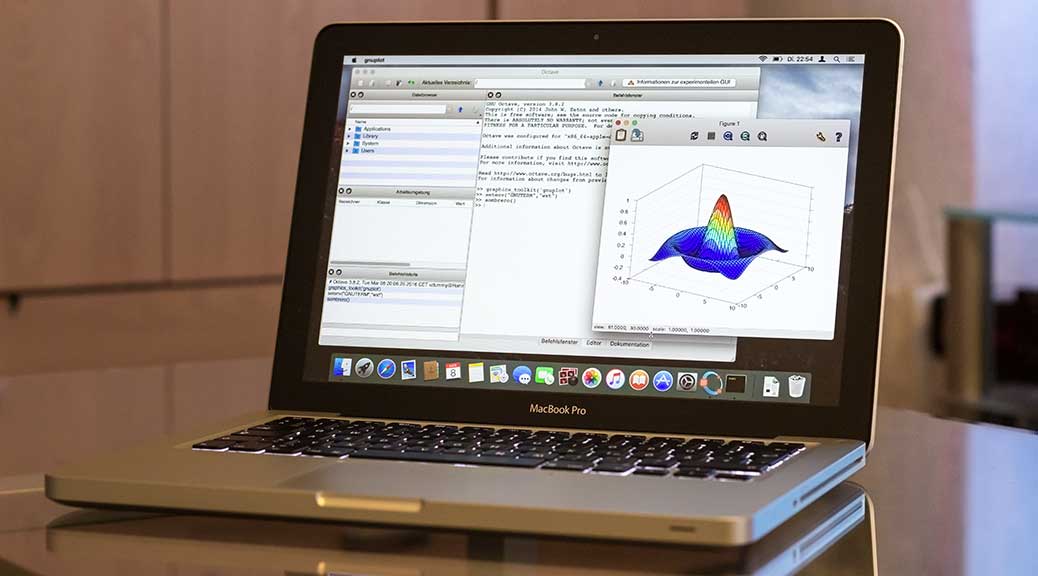Gnuplot For Mac Os X Download
- Hello Here is an additional comment to JIMCLARK01's tips to compile gnuplot 4.4.2 under Snow Leopard (Mac OS X.6) with PNG, JPEG output available: X11 should be installed on your computer (From Mac OSX install DVD). Gnuplot needs libgd library to support graphics output formats like PNG.
- Gnuplot download Current gnuplot major version is 5.4. The most recent release was 5.4.2 (June 2021) Downloads offered by others. 3rd party OS/X binaries.
Octave 4.2.2 VM installer for Mac OS X 10.10 Yosemite, 10.11 El Capitan, 10.12 Sierra, 10.13 High Sierra[edit]
Point and click configuration files that cause Vagrant to automatically download and configure an Octave 4.2.2 server VM under OS X including 10.10 Yosemite, 10.11 El Capitan, 10.12 Sierra and 10.13 High Sierra. The install process pulls down Octave 4.2.2 from the repository. All software used in running this server VM is open source (Vagrant, VirtualBox, Octave). The Octave GUI and graphics will display seamlessly on the Mac via the Mac's native X-windows server, while the server runs headless. The recommended configuration ensures that by default user files written by the GUI are in a folder shared with the Mac's filesystem, and the VM suspends automatically when the user quits the GUI. Any edited files then persist in the Mac's shared folder.
Gnuplot for Mac is a portable command-line driven graphing utility for Mac OS X, Windows, OS/2, VMS, and many other platforms. Gnuplot for Mac is able to generate both 2D and 3D plots; delivering the results in animated views. You can also save the graphs to a variety of image formats, including PNG, SVG, JPEG and EPS. Supported outputs include. Download Scisoft OSX PPC for Mac to astronomical software collection (ppc only). Scisoft for Mac OSX PPC is a collection of astronomical software for Mac OS X 10.4 PPC and above. Aug 09, 2017 After scratching my head over it for two days straight, I finally installed gcc, gnuplot, Octave and LaTeX on my new Mac (OS X 10.10.3, Yosemite) and decided to note some points/instructions down here for anyone else looking for a simple solution from start to finish contained in one place.
Binary installer for OS X 10.9.1[edit]
A binary installer for Mavericks can be found on Octave Forge.
This installer will install all binaries for GNU Octave 3.8.0 itself and its dependencies under

And will create two entries in the Applications folder
Which will start Octave in CLI and GUI mode respectively, these are just small wrappers containing a startup script and an icon to allow launching Octave from the Finder.
If you wish to uninstall GNU Octave 3.8.0 and all other software installed by this installer you can simply move the three folders listed above to the Trash. Notice that you will need to authenticate with an administrator password to be allowed to do so.
You may need to override Gatekeeper to allow installation. You may find instructions about how to do this on this page in the section labeled 'How to open an app from a unidentified developer and exempt it from Gatekeeper'.
In short:
- In Finder, Control-click or right click the icon of the app.
- Select Open from the top of contextual menu that appears.
- Click Open in the dialog box. If prompted, enter an administrator name and password.
This installer is known to work on OS X 10.9.1, you may try, at your own risk, to use it for installing on other system versions but it is not guaranteed to work.
MacPorts: Custom Installation Instructions[edit]
Gnuplot On Windows
For best performance, variability and reliability the custom installation is suggested.
Preliminary Port Installations
- The new Octave 4 port relies on the accelerator variant. Unfortunately this variant is known for some problems (see below). A better alternative is the 'atlas' port, it is necessary to build it with the here specified variant prior to the Octave port installation:
sudo port install atlas +gcc5. This can last for many hours. Do this overnight. If a prior atlas installation failed, dosudo port clean atlasbefore reinstallation. - Octave depends on arpack, too. Unfortunately arpack is installed with the accelerate variant by default. The accelerate variant uses Apple's Vector Libraries which have some known bugs that can cause Octave to crash if using certain functions in arpack. To avoid this install arpack with the atlas variant instead of the accelerate variant
sudo port install arpack -accelerate+atlas. You can even do this after you installed Octave. The new variant become active by default.
Octave Installation
- MacPorts has good support for Octave. A list of what MacPorts has available for Octave is here. To install the most recent version of Octave, type
sudo port install octave -accelerate+atlasat the Terminal's command line. Octave has many dependencies which will be downloaded and installed prior to Octave. The entire installation process can take some time. - Note that
octave-develhas been replaced byoctave, see MacPorts Revision 114034. - The variant installed may be important to the user's experience. The available variants for
octaveare displayed by typingport variants octave. In MacPorts 2.3.4 the variants accelerate, app, docs, fltk, gfortran, graphicsmagic, qt4gui and sound are installed by default (marked with '+' sign inport variants octaveoutput). If you need Java support add the new Java variant (+java). A installed Java JRE is mandatory. Go To the Oracle Java website for Download. The following command works fine:sudo port install octave -accelerate+atlas+java If Octave crashes when plotting use the Gnuplot graphic toolkit instead of FLTK. Typegraphics_toolkit('gnuplot')in Octave before plotting. For using the nicer wxt-terminal of Gnuplot, typesetenv('GNUTERM','wxt')in Octave. To make this the standard behavior append both commands in one of Octave's startup files e.g. your~/.octaverc. To close the graphic window of gnuplot use the Octave commandclose()to get rid of the Gnuplot instance instead of using the close button of the window.- The first plot after startuing Octave 4 can last a while.

To get detailed instructions from start to end on one page, refer Hani's Omnium Gatherum.
Fink installation instructions[edit]
→ Latest Octave: Version 3.8.2
The Fink project uses dpkg and APT (Debian's package management system), as well as its own frontend program, fink (which is implemented as a set of Perl modules).

Install GNU Octave using Fink:
Gnuplot For Mac Os X Downloads
- Install Xcode via the Mac App Store.
- Install the Command Line Tools by opening a terminal and type
sudo xcode-select --install.
- Install the Command Line Tools by opening a terminal and type
- Follow Fink's installation instructions.
- Fink has excellent support for Octave and includes recent as well as dated versions. A list of what Fink has available for Octave is here. To install the latest Octave with GUI support, type
fink install octave-qtmacorfink install octave-qtx11at the Terminal's command line. For those running the 64 bit version of Fink, it is recommended thatoctave-atlas-qtmacoroctave-atlas-qtx11be installed instead as there are some bugs/features with Apple's vecLib for the X86_64 architecture. Octave has many dependencies which will be downloaded and installed prior to Octave. The entire installation process can take many hours. - Fink should also be used to install [packages for Octave. For example, the control systems package may be installed by typing
fink install control-atlas-oct382at a terminals command line.

For the doc() function to be supported by Octave, either the unversioned octave, octave-atlas, or octave-ref package must be installed. Essentially, those features used at run-time which don't have a version somewhere in the file path are included in these packages.